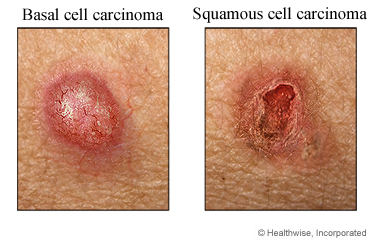Curettage and Electrosurgery for Non-Melanoma Skin Cancer: Care Instructions

Overview
Curettage and electrosurgery is a procedure used to remove skin cancer. Basal cell and squamous cell cancers are types of cancer in which abnormal skin cells grow out of control.
Most cases of these types of cancer can be cured if they are found and removed early. If the cancer is not completely removed, it may come back.
The procedure is usually done in your doctor's office. After numbing the area, the doctor scrapes the top layers of skin away with a spoon-shaped tool (curette). Then the doctor heats the surface of the wound with an electric current through a metal tool or needle (electrosurgery). This helps control bleeding and destroys any cancer cells that remain.
The doctor may repeat the process 2 or 3 more times. The doctor scrapes a little beyond the edge of the cancer to help remove all the cancer cells. The wound is then covered with ointment and a bandage. A scab will form over the area.
The wound may take 3 to 6 weeks to heal. How long it takes depends on the size of the area treated. Good wound care may help the scar fade with time.
The tissue that was removed will be sent to a lab to be looked at under a microscope. This is done to confirm if the tissue is skin cancer.
Follow-up care is a key part of your treatment and safety. Be sure to make and go to all appointments, and call your doctor or nurse advice line (811 in most provinces and territories) if you are having problems. It's also a good idea to know your test results and keep a list of the medicines you take.
How can you care for yourself at home?
- If your doctor told you how to care for your wound, follow your doctor's instructions. If you did not get instructions, follow this general advice:
- Wash around the wound with clean water 2 times a day. Don't use hydrogen peroxide or alcohol, which can slow healing.
- You may cover the wound with a thin layer of petroleum jelly, such as Vaseline, and a non-stick bandage.
- Apply more petroleum jelly and replace the bandage as needed.
- Be safe with medicines. Read and follow all instructions on the label.
- If the doctor gave you a prescription medicine for pain, take it as prescribed.
- If you are not taking a prescription pain medicine, ask your doctor if you can take an over-the-counter medicine.
When should you call for help?
Call your doctor or nurse advice line now or seek immediate medical care if:
- You have signs of infection, such as:
- Increased pain, swelling, warmth, or redness near the area.
- Red streaks leading from the wound.
- Pus draining from the wound.
- A fever.
Watch closely for changes in your health, and be sure to contact your doctor or nurse advice line if:
- You see a change in your skin, such as a growth or mole that:
- Grows bigger. This may happen slowly.
- Changes colour.
- Changes shape.
- Starts to bleed easily.
- You do not get better as expected.
Where can you learn more?
Go to https://www.healthwise.net/patientEd
Enter U269 in the search box to learn more about "Curettage and Electrosurgery for Non-Melanoma Skin Cancer: Care Instructions".
Current as of: December 4, 2024
